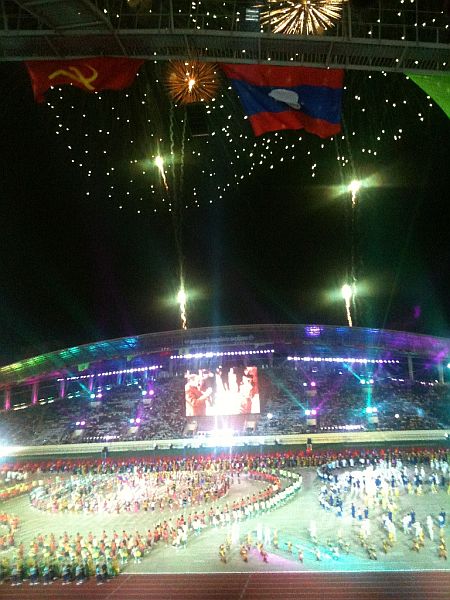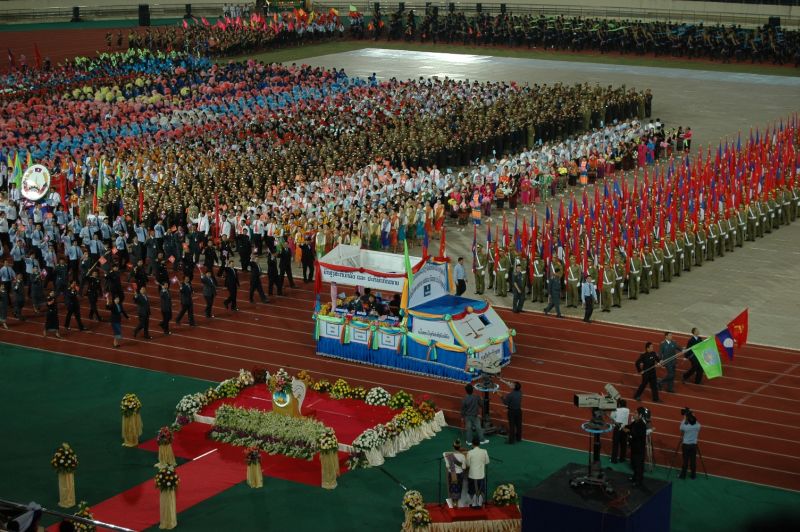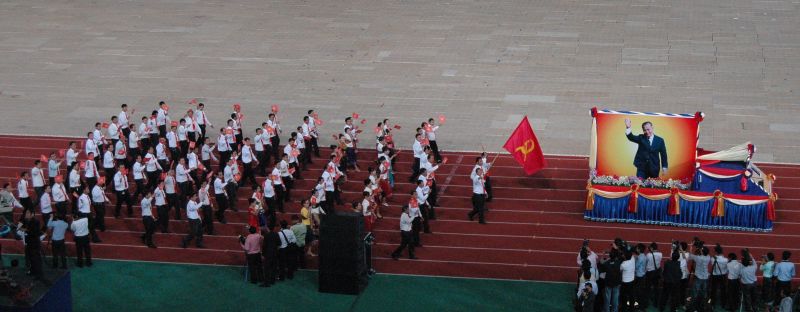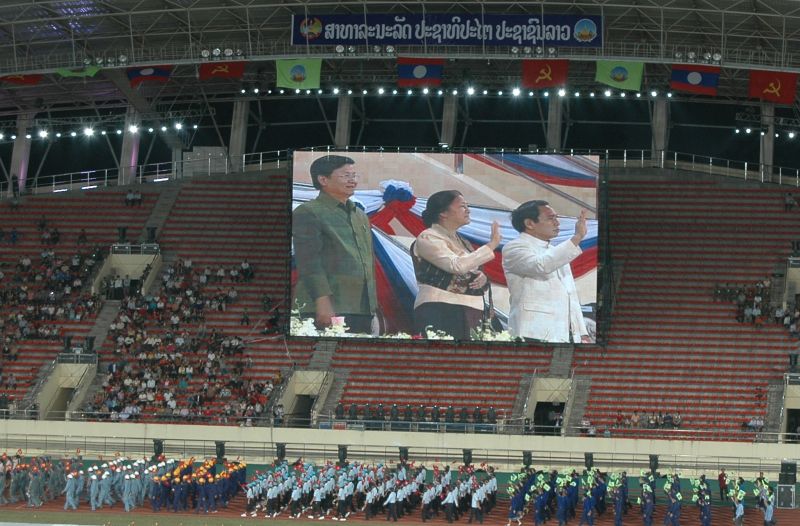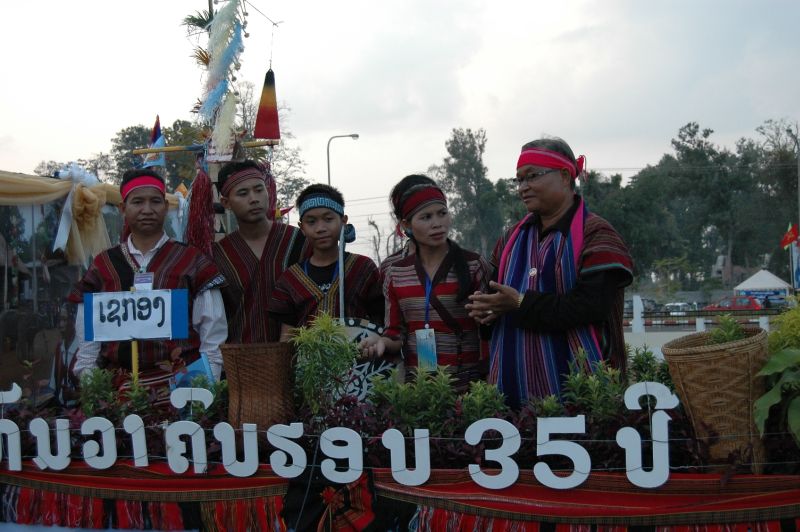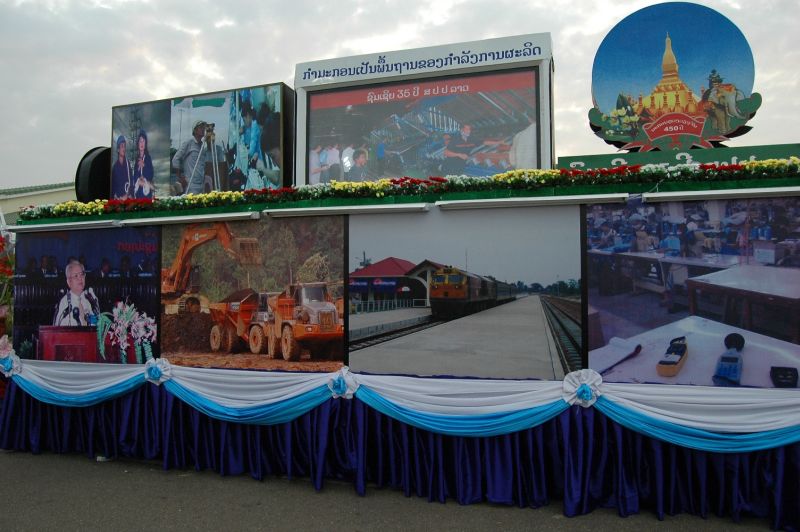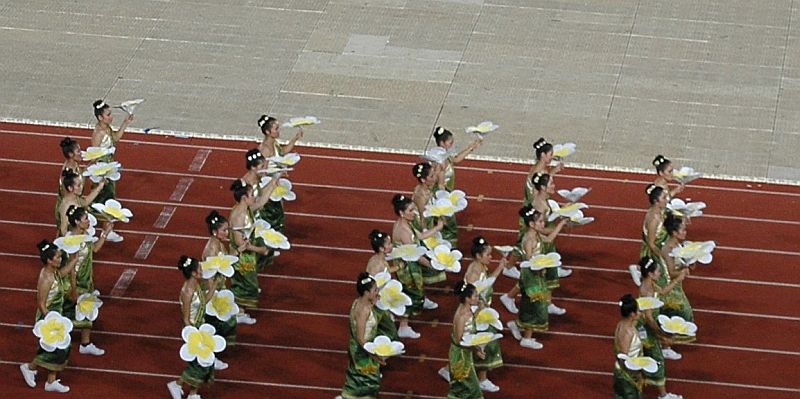“Lao people have finally become the true owners of their nation” — Vientiane Times, 20.11.2010
Laos is now getting used to organizing impressive big events. Last year Laos organized the SEA Games – this year it is the 450 years celebration of Vientiane as the capital. And this was not the only anniversary to be celebrated. It was held in conjunction with the 35th anniversary of the Lao People’s Democratic Republic on the 2nd of December and with the 90th birthday of late Kaysone Phomvihane on the 13th of December.
It almost seems like the national sport nowadays is to collect and celebrate anniversaries. In December there will also be a procession in Luang Prabang for the 15th anniversary as a World Heritage Site. We suspect there must be a “Ministry of Celebrations” in Laos.
With so many anniversaries we had to choose. We decided to go to the 450th anniversary of Vientiane. It was difficult to find information about the date of the event, the starting time and where to get the tickets. Some said that tickets should be on sale in the black market, others told us tickets were free but sold out and some people just didn’t know where to get tickets. Even the Tourism Office could not give us any useful hints. Needless to say Internet did not give the answers either. If anything information was inconsistent. So we decided to try our luck and we went to the stadium at km 16 without tickets but with determination to get in.
On the way to the stadium we stopped at the Kaysone Memorial. This place seemed like an appropriate start to get in the right mood for the celebrations. We arrived late at the memorial, so our guide was in a hurry and nearly pushed us out of the museum after he showed us Kaysone’s house of birth, portraits of his parents and siblings, photos and other objects he used in his lifetime. We were curious and asked the guide whether he would go to the stadium that evening for the celebration. He answered very honestly: “Yes, I have to.” We didn’t have to attend but we wanted to, so off we went on our motorbike.
Together with 10,000-or-so other small motorbikes we arrived at the stadium. We did not worry about how on earth we were going to find our small bike later that evening but instead we looked around to come up with a “stadium entry strategy”. There was a lot to see – and eat! We took the first hurdle without hesitation by pretending we had tickets and knew where to find our seats. Passing the second checkpoint gate was more complicated as there were officials checking each person’s ticket. It was time for a change in strategy. We addressed a young man with a black suit in Lao: “Kho thot ai, nyang bo dai bat soen” – sorry, elder brother, we didn’t get our invitation cards yet, adding that we came all the way from Germany to celebrate the 450-year-anniversary – which was actually true. The elder brother could not resist this emotional appeal and he guided us towards another entrance into the stadium. We were in! And we even got two of the blue stadium seats on the rim. Immediately the celebrations started. Had they been waiting for us? Anyway it was perfect timing.
President Choummaly arrived on the red carpet – presented within the stadium on the huge screen – he got standing ovations. He shook hands and smiled like a Hollywood-star.
The parade started at 6 p.m. with the Laos people’s Revolutionary Army orchestra entering the stadium while playing marching music. The Army Orchestra was followed by all 17 provinces which displayed on a wagon their respective regional attractions to the audience. Then 200 traditionally dressed inhabitants of every province made their way into the stadium. Vientiane symbolically had 450 people! Important institutions like the Women’s Union, the veterans of the liberation and others followed, displaying the typical symbols that are so vivid in the party slang and stand for modernisation: garment industry, electricity, road construction, engineers, production and natural resources. The health wagon said “if you are healthy, it helps the country to strengthen.” And finally there were different dance troupes with names that speak for themselves like Nang Keo dance troupe, boat racing dance troupe, New Year festival dance troupe, rocket festival dance troupe, golden rice field dance troupe, traditional muay lao (Lao boxing) dance troupe and aerobic artist troupe. All the groups lined up in the middle of the stadium and this made a very colourful picture (see photos below, including some of the floats).
Somsavat Lengsavad, President of the official preparation committee and deputy Prime Minister officially opened the celebrations with a report. He mentioned major achievements as the casting and consecration of King Anouvong statue, improving roads, publishing a historical book on Vientiane, and also the successfully achieved goals of Vientiane, the hok so (р║к) or six s’s: so-saad (cleanliness), so-sikhiau (green – i.e. parks, trees), so-sagnop (peacefulness in the sense of no crimes), so-sivilai (civilisation, prosperity), so-sawaang-sawai (illumination) and so-sanae (charming). He spoke very energetically and to the point, stressing “the Lao people have never witnessed the celebration of Vientiane as the capital city by any monarchy at any moment in time” (Vientiane Times 20.11.2010: 4).
Sombat Yialiher, mayor of Vientiane, stood next to Somsavat. It came as some surprise to us that, as Vientiane mayor, he didn’t say a word.
Somsavat then handed over to sahay (comrade) Choummaly Sayasone who spoke very softly and was hard to hear. A friend of mine told me that he spoke faster than usual. Choummaly told the story of Vientiane, and warmly welcomed the Lao compatriots living abroad. He referred to them as khon lao thi yu dtang pathet (Lao who live abroad) rather than as khon lao nok (outside Lao) – a more excluding term often heard in the past. When the camera zoomed in on the big screen we saw someone holding up a poster that said “Belgique”. During his 20 min speech there were short rounds of applause and ruffle of drums but also a lot of noise from the audience. He finished his speech with an erected fist and en energetic man nyuen (“long live” – as in long live the Lao PDR).
Suddenly there were the sounds of birds chirping, chickens crowing and cows mooing. Hundreds of dancers in colourful dress whirled with big artificial fish on sticks, others with swinging yellow scarves, symbolizing the swaying rice and “Laos’ natural abundance, which enables people to survive and earn a living” (Vientiane Times 20.11.2010, S. 2). In the background on the big screen appeared the beauty of various landscapes with beautiful waterfalls, the Mekong with four thousand islands in the south, forests and mountains in the north, coffee and other fruits of Laos, fishing and rice harvesting people and activities like the pi mai (new year), bun bang fai (rocket festival), bun that luang (That Luang festival) and other religious ceremonies.
The historical part showed the beginning of Lan Xang, the unification through King Setthathilat – projected by a laser in different colours on the stadium field and King Setthathilat announcing the movement of the Laotian capital from Luang Prabang to Vientiane.
All of a sudden thunder and lightning, the dancers fell to the floor as if thunderstruck. “The hardship and pain experienced when the country was invaded” (Vientiane Times 20.11.2010: 2) was shown with coloured paintings of invading Burmese and Thai troops, the same ones that are also on display in museums nationwide. The paintings were reinforced with bombastic and aggressive music. Old black and white pictures showed the French repressing the Lao people, by forcing them to do compulsory labour, and the American bombardments.
A timewarp: nice and lovely Lao-Vietnamese folk music lured the audience into the 1960s, represented by black and white photographs from the old revolutionaries. Kaysone, Souphanouvong and their comrades were shown while they were working in the caves, training soldiers and struggling for the freedom of the country. The big finale showed the “present time of rapid development under the leadership of the Lao People’s Revolutionary Party” (Vientiane Times 20.11.2010: 2).
At 8 p.m. all the lights went off. This was not a power failure but intentional: 100 men and 100 women, all dressed in Lao traditional clothes, came in. Pink and red lights flashed while they sang two songs that were composed for this occasion. After a formal nop (Lao respectful greeting) they left. A laser projected “sabaidee” and the That Luang on the ground.
A fireworks display followed, which for many people in the audience seemed to be the highlight of the evening. It lasted for about 10 minutes and the celebration was over. People left the stadium while the screen showed the major achievements of the Lao republic in the last three-and-a-half decades. The film was made by the Department of Cinema from the Ministry of Information and Culture. It showed big airplanes, the new train station and the opening of the Lao Thai Friendship-bridge with the Thai kings’ visit. All images displayed during the celebrations showed Vientiane as a modern up-to-date-city.
Over 11,700 persons took part, including 200 Lao compatriots living abroad and delegations from 31 countries. Specially for the anniversary, a flag was created showing the That Luang, dok champa (frangipani, the national flower) and King Setthathilat riding on an elephant’s back – the same symbols that also marks the new 100,000 Kip-note.
Laos has made some big steps in developing its self confidence when it comes to organizing big events.
What a big contrast to the ASEAN summit in 2004. Before the ASEAN summit one could hear doubting voices whether “a small and laid-back-country like Laos” would be able to host such a big event and provide a guarantee for security. In order to avoid any risks and negative publicity, borders around Vientiane were closed at that time. For some days no visa were issued and there was a curfew after 10 pm. Women would be fined if they were not wearing traditional clothes.
Media coverage on the 450 year anniversary was, as expected, uncritical and repetitive. Nearly a week after the big event, we could see the same pictures and even interviews over and over again on TV. And we read about the great achievements under the Party leadership. Say it often enough and people will believe it. No wonder the intention was “to acquaint the entire Lao people, in particular the residents of Vientiane, with the origins, background history and the fine traditions of Vientiane…” (Vientiane Times 20.11.2010: 4).
Laos started with external marketing. The successful organization of the SEA games was a demonstration to the outside world that Laos could in fact organize a big event. The 450 years celebration was an example of internal marketing. The Lao rulers wanted to show its citizens the history, political unity and cultural diversity of the country. In fact, the outside world barely noticed. In Cambodia more than 300 persons died in a stampede and in Bangkok none of our Thai friends heard anything about the 450 years celebration. For us it was an evening of celebration and (new) impressions. We still wonder how successful this internal marketing campaign has been. Before we had the answer we found our motorbike and joined the traffic back to the city centre. Early next morning another “celebration” was waiting: the That Luang Festival. Thanks to the “Ministry of Celebrations”.
Anke Timman is a part-time researcher on Laos and Jiri van den Kommer is a first-time observer of the country.
 Facebook
Facebook  Twitter
Twitter  Soundcloud
Soundcloud  Youtube
Youtube  Rss
Rss 